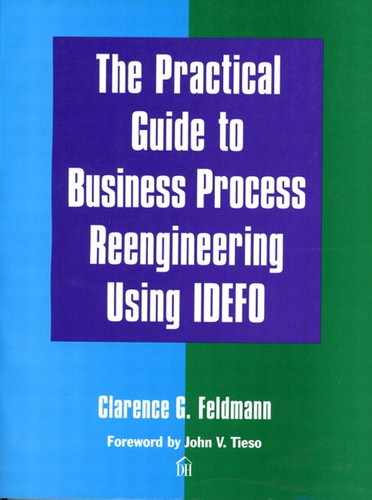Figures & Tables
Figure 1-1: Simple Box and Arrow Graphics.
Figure 1-2: Simple Control Graphics.
Figure 1-3: Simple Mechanism Syntax.
Table 2.1. The DoD/CIM 25-Step BPR Process.
Figure 2-1: Keep Contract “Actuals” Records.
Figure 2-2: Organize & Manage the Effort.
Figure 2-3: Develop Company’s Public Image.
Figure 2-4: Node Diagram of Hiring Model.
Figure 2-5: Be a Successful Group General Manager.
Figure 2-6: Run Successful Group Operations.
Figure 2-7: Establish Local Group Controls.
Figure 2-8: Evolve the Enterprise Over Time.
Figure 2-9: Run the Enterprise.
Figure 2-10: Manage the Enterprise.
Figure 3-1: Breakdown into Six or Fewer Activities.
Figure 3-2: Top-Down IDEFO Model Structure.
Figure 3-3: A Data Flow Diagram to Track Assembly Status.
Figure 3-4: Same Track Assembly Status Data Flow Using IDEFO Format.
Figure 3-5: Assembly Status Tracking IDEFO Diagram, with Physical Parts Assembly Added.
Figure 3-6: Previous Diagram, with Controls Added.
Figure 3-7: Complete IDEFO Diagram, with Mechanisms Added.
Figure 3-8: A Typical IDEFO Diagram.
Figure 3-9: Mechanism at a Lower Level of Abstraction.
Figure 4-1: Activity Box Syntax.
Figure 4-3: Semantics of Arrow Forks and Joins.
Figure 4-4: The IDEFO Diagram Form.
Figure 4-5: Diagram of the IDEFO Modeling Process.
Figure 4-6: Model Structure of Diagrams.
Figure 4-7: A-0 Diagram with Purpose and Viewpoint.
Figure 4-8: Node Structure of a Model.
Figure 4-9: Sample Node Diagram.
Figure 4-10: ICOM Code Definition.
Figure 4-11: Remote Reference.
Figure 4-12: Reference Expression Illustrations.
Figure 4-13: Illustration of ICOM Coding to Connect Boundary Arrows.
Figure 4-14: Mechanism and Call Syntax.
Figure 4-15: Multiple Mechanisms.
Figure 4-16: Mechanism Arrow Branching.
Figure 4-17: Call Points to Further Detail.
Figure 4-18: Multiple Calls to a Common Model.
Figure 4-19: Default Values at Model Interfaces.
Figure 4-20: Call to Separate Process Models.
Figure 4-21: Examples of Mechanism and Call Combinations.
Figure 4-22: Examples of DRE and Call Arrow Use.
Table 5-1. IDEFO Project Personnel.
Figure 5-1: Arrow Layout Rules.
Figure 5-2: A Highlighted Diagram.
Figure 5-3: A Publication Format Diagram.
Figure 5-4: Intermodel Tie Syntax.
Figure 5-5: Management Viewpoint Model.
Figure 5-6: Technical Viewpoint Model.
Figure 5-7: Call Arrow Illustration.
Figure 5-8: Sample Node Diagram for Communicating Model Content.
Figure 5-9: Process of Creating a Schematic.
Figure 5-10: FEO Showing First Librarian Event.
Figure 5-11: The Raveled-Rope FEO.
Figure 5-12: Arrow Trace Process.
Figure 5-13: The Reader/Author Cycle.
Figure 5-14: The Reader Kit Cover Sheet.
Table 6-1. Summary of IDEFO Rules.
Figure 6-1: Box Numbering Convention.
Figure 6-2: Input, Output, and Control Conventions.
Figure 6-3: Activity Naming Convention.
Figure 6-4: Plug-in Alternative TO-BE Processes.
Figure 6-5: Boundary Arrow Compatibility Requirement.
Figure 6-6: Arrow Uniqueness Rule.
Figure 6-7: Arrow Flow-Restriction Rule.
Figure 6-9: Flow Chart and IDEFO Diagram Conventions Compared.
Figure 6-10: Manufacturing Diagram with Mixed Viewpoints.
Table 6-2. Personnel, Their Activity Level, and Their Viewpoints.
Figure 6-11: Manufacturing Diagram with Technical Viewpoint.
Figure 6-12: Manufacturing Diagram with Quality Viewpoint.
Figure 6-13: Manufacturing Diagram with Financial Viewpoint.
Table 6-3. Definition of the Fog Factor.
Figure 6-14: Comparison of Arrow Labels.
Figure 6-15: Comparing Names and Labels.
Figure 6-16: A Too-Simple Diagram.
Figure 6-18: Lack of Arrow Bundling.
Figure 6-19: Equivalent Diagram with Arrow Bundling.
Table 6-4. Common Labels for Control-Oriented Arrows.
Table 6-5. Common Mistakes and Their Solutions.
Figure 6-20: Content-Free Diagram.
Figure 6-21: Clarified Diagram.
Figure 6-22: First Attempt at an ERDA Diagram.
Figure 6-23: Function-Oriented Improved Diagram.
Figure A-1: Process versus Function Modeling.
Figure A-2: Decomposition Example.
Figure A-3: Sequential Example.
Figure A-4: Organizational Example.
Figure A-5: Split-by-Type Example.
Figure A-6: Partial SBT Example.
Figure B-1: Candidate Top-Level Generic Enterprise Diagram.
Figure B-2: Alternative Candidate Top-Level Generic Enterprise Diagram.
Figure B-3: AS-IS Enterprise Model.
Figure B-4: AS-IS Enterprise Model.
Figure B-5: AS-IS Enterprise Model.
Figure B-6: AS-IS Enterprise Model.
Figure B-7: AS-IS Enterprise Model.
Figure B-8: AS-IS Enterprise Model.
Figure B-9: AS-IS Enterprise Model.
Figure B-10: AS-IS Enterprise Model.
Figure B-11: AS-IS Enterprise Model.
Figure B-12: AS-IS Enterprise Model.
Figure B-13: Configuration Management Model.
Figure B-14: Configuration Manager’s View.
Figure B-15: Configuration Manager’s View.
Figure B-16: Configuration Manager’s View.
Figure B-17: Configuration Manager’s View.
Figure C-1: Diagram with Q-Label Quantification.
Figure D-1: Example of IDEFO, IDEF1X, and Business Rule Relationship.
Figure E-1: Diagram Authoring Steps.
Figure E-2: Step 1, Purpose and Viewpoint.
Figure E-3: Select Purpose, Continued.
Figure E-4: Select Purpose, Continued.
Figure E-5: Select Purpose, Continued.
Figure E-6: Statement of Purpose.
Figure E-7: Selected Viewpoint.
Figure E-8: Step 2, List Data and Activities.
Figure E-9: Step 3, Cluster and Bundle.
Figure E-10: Results of Clustering and Bundling.
Figure E-11: Step 4, Lay Out Boxes.
Figure E-12: Operate Ben’s Burgers.
Figure E-13: Step 5, Add Arrows.
Figure E-14: Operate Ben’s Burgers.
Figure E-15: Operate Ben’s Burgers.
Figure E-16: Operate Ben’s Burgers.
Figure E-17: Operate Ben’s Burgers.
Figure E-18: Operate Ben’s Burgers.
Figure E-19: Operate Ben’s Burgers.
Figure E-20: Manage Local Restaurant.
